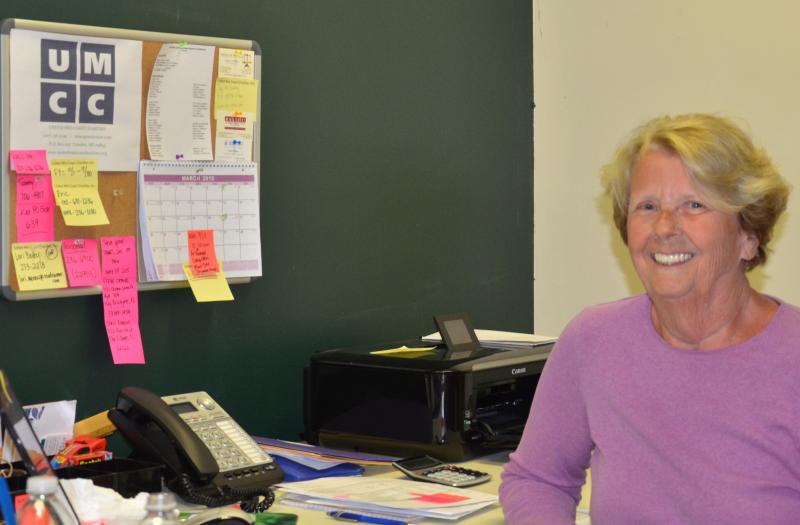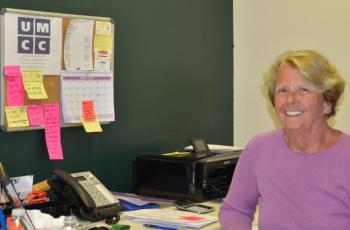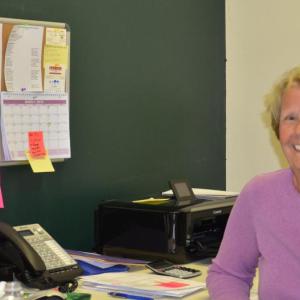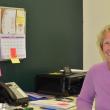United Mid-Coast Charities leaders enthusiastic about nonprofit’s future
CAMDEN — While Attorney Jay McCloskey is working at his end to reclaim money that had been donated to United Mid-Coast Charities, yet allegedly never made it to the right bank account, the organization itself is “doing very, very well,” said President Steve Crane, at the end of March. UMCC’s annual autumn campaign raised $275,000, which included a $50,000 matching challenge from an anonymous donor.
“We are getting this all behind us,” Crane said, as expectations rise that a federal indictment of UMCC’s former president Rusty Brace will be forthcoming over the next few weeks.
Since last fall, UMCC leaders said the nonprofit has reinforced its policies and system of checks and balances within its bookkeeping.
Jack Williams, the nonprofit’s second vice president, said March 25 that UMCC has thoroughly reviewed its practices, and has in place good fiscal monitoring procedures. This now includes ensuring that two UMCC representatives visit the post office to retrieve the mail, not just one.
Each piece of mail is opened and catalogued by two people, he said. A third person checks the entries and amounts. UMCC enlisted an outside organization to help review its policies.
“The system is as good as it can get,” said Williams.
UMCC relocated its office from the Brace Building to new quarters down the street to the corner of Washington and Mechanic streets.
After UMCC filed suit against Brace in October, other Midcoast nonprofits have reexamined their own practices, inviting consultants to board meetings to talk about how embezzlement and fraud manifests, and the importance of annual audits.
In Maine, there are approximately 6,000 nonprofits. In Camden alone, according to the Internal Revenue Service, there are 77 organizations eligible to receive tax-deductible charitable contributions; in Rockland, 85; and in Belfast, 63. Many more are headquartered throughout Knox, Waldo and Lincoln counties, with a good number of them relying on donations to fulfill their missions.
And like any business, school and corporation, there perpetually hovers the possibility of fraud, as long as humans are tending the books.
At the Portland-based Maine Association of Nonprofits, Executive Director Scott Schnapp stresses organizational accountability and responsibility in the prevention fraud.
“The UMCC situation should serve as a call to action for nonprofit leaders to use resources available that ensure the establishment of a mission-based organizational culture with transparent and accountable business practices,” he said.
MANP was founded in 1994 to “strengthen the leadership, voice, and organizational effectiveness of Maine nonprofits so they can better enrich the quality of community and personal life in Maine.” It currently has 800 members.
In MANP’s Guiding Principles and Practices for Nonprofit Excellence in Maine, a section is dedicated to addressing fraud and recommends that a nonprofit should “promptly acknowledge and thank donors for every gift, regardless of amount, including in-kind donations.”
At the Maine Women’s Fund, a nonprofit with offices in Camden and whose mission is to raise money and distribute to other nonprofits around the state, Chief Executive Officer Sarah Ruef-Lindquist said she ensures that all donors and prospects for gifts of $1,000 ore more are assigned at least one board member. The details about those donors and their gifts are shared with the board.
“Nonprofits should engage in ongoing efforts to openly convey information to the public about their missions, activities and decisionmaking processes,” he said. “This information should be easily accessible to the public and should create external visibility, public understanding and trust in the organization, while protecting sensitive or confidential information.”
One bookkeeper, who visited a local nonprofit to talk about audits, suggested the organization list at its website each donation received, with or without associated names. That way, whoever contributed could see that their donation had been received and processed.
Like UMCC, the Women’s Fund sends two people to retrieve and open mail. Checks made out to the Women’s Fund get deposited directly to the bank via a scan from the office so that no staff member leaves the office to make a deposit.
Scanned deposits are copied to the director and the finance and human resources manager, who enters them into an account system. A second person enters them into the donor gift database, and those are reconciled monthly.
“We both see them, and our treasurer, finance committee and full board see them at least quarterly,” said Ruef Lindquist. “It's unusual to receive a large gift by check. Most larger gifts are made with securities.”
Rebuilding the trust of a community following an incident of fraud is essential, Schnapp said.
“This story should serve as a cautionary tale for nonprofit boards and reinforce the responsibility they have to their donors and their community in ensuring that their nonprofits operate with the highest level of integrity and mission based transparency,” he said. “It is critically important for nonprofit boards to not only do a thorough analysis of how the breach occurred, but also to communicate openly with their donors and community about the changes that have been made to address the problem. If this isn’t a wakeup call, what is?”
The UMCC case made national news, not only for the sheer amount of money cited, but because it is described in court documents as taking place over 13 years.
But UMCC is recovering, Crane said, and is continuing to raise funds now despite the lawsuit. Crane credits the community for its generosity.
UMCC annually holds a fall fundraising campaign, and in 2014 the nonprofit sent out 1,400 appeal letters.
“The response to our appeal was strong,” he said. “And, we had people calling [with donations]. We are heading very quickly in a new direction.”
A local anonymous donor agreed to match up to $50,000 for every dollar the organization raised during the year’s end fundraising campaign.
In the end, UMCC raised $275,000 during that fall campaign, Crane said.
“The response was tremendous,” he said. “The community really is behind UMCC.”
The nonprofit is now getting ready to launch a spring fundraising campaign.
As UMCC regains momentum, it is ready to begin its annual screening of grant recipients. Every year, nonprofits submit applications to UMCC seeking funding.
Then, each of the 45 directors goes into the field, interviewing the organization or agency, and analyzes financial statements. After that, the UMCC Allocation Committee decides how much money will get distributed to which organization. At the annual meeting in August, the entire board of directors votes on the final allocations.
UMCC also participates in payroll deduction programs at Fisher Engineering, in Rockland; University of Maine; Down East Enterprise; Waldo County General Hospital and Pen Bay Healthcare; Camden National Bank; and Waldo County YMCA.
All the money for UMMC is raised in Knox and Waldo counties.
In 2012, UMCC raised approximately $226,255 in contributions. In 2013, according to its tax filing, UMCC raised $274,768 through donations. UMCC also has an endowment fund, and has held fundraising events, increasing annual income approximately by another $90,000 each year.
Last October, United Mid-Coast Charities distributed $325,150 to area nonprofits in its annual ceremony held Oct. 9 at the First Congregational Church in Camden.
The largest recipients included Broadreach Family & Community Services ($30,000), Penobscot Bay YMCA ($30,000), Waldo County YMCA ($25,000), and Knox County Homeless Coalition: Hospitality House ($15,000). Other recipients included Area Interfaith Outreach, Belfast Area Children's Services, Knox County Health Clinic, New Hope for Women and Belfast Soup Kitchen.
Related stories
• Rusty Brace asks for more time in UMCC case as investigation continues
• The First discloses amounts in Brace accounts
• Legal, investigative wheels turn on Camden charity theft case
• Camden business files suit against Rusty Brace; UMCC will be stronger, more transparent, board president says
• Camden’s UMCC files suit against Rusty Brace, wants $3.8 million returned
• Camden’s United Mid-Coast Charities embezzlement investigation underway, says president
Editorial Director Lynda Clancy can be reached at lyndaclancy@penbaypilot.com; 207-706-6657.
Event Date
Address
United States





























